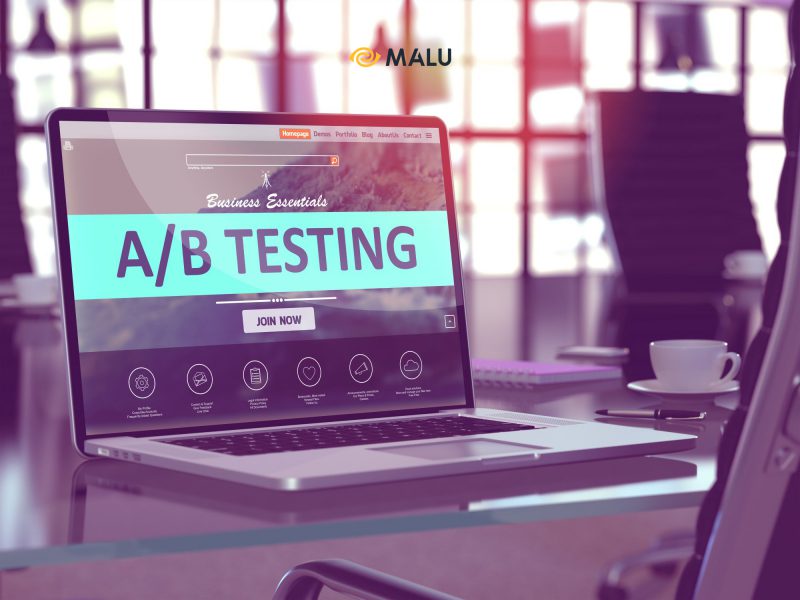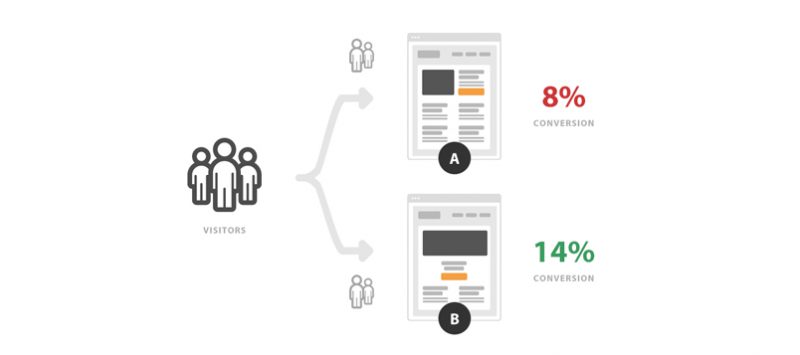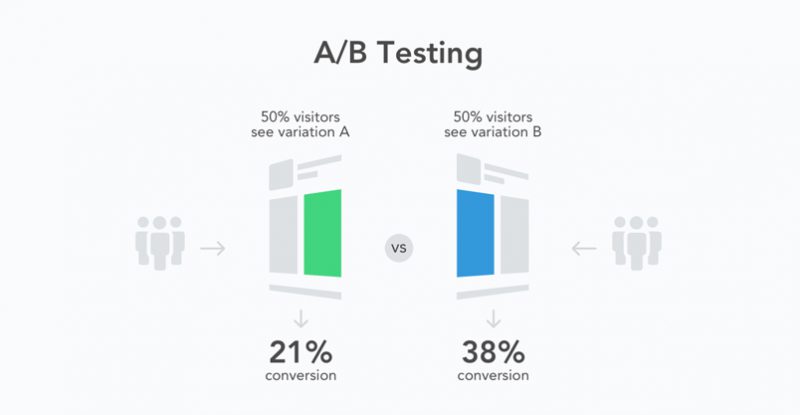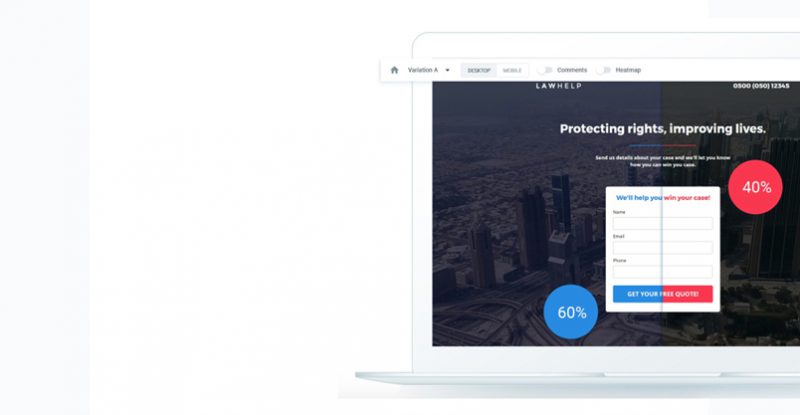
What is A/B Testing? How to implement A/B testing? When building a landing page, writing email content marketing or designing a CTA button, the most important goal is to have the highest conversion rate from users.
However, we often impose our emotional thinking when setting up marketing campaigns. This can have a negative impact on the overall outcome because the customer’s needs and wants are often far different from what you imagine. That’s why A/B tests have become so important and necessary for businesses.

But A/B testing can be complicated for the vast majority of people who are new to marketing campaigns for the first time. If you are not careful, you can completely do trial and error with the result that the conversion rate does not meet your expectations. The following article will help you have a better overview of A/B Testing
First, you need to keep in mind: To run an A/B test, you need to create 2 versions of the content with the change appearing in only a single variable. This variable can be the color of the CTA button, the navigation scale, the content in the landing page, etc. Then you run both versions simultaneously for a certain period of time. That is a simple way to understand the process of running A/B Testing.
1. What is A/B Testing?
A/B Testing helps marketers to observe and test how changes in marketing content impact the conversion rate of users (Conversion rate, also known as CR). From there, managers can make suggestions and decide whether to apply the changes in practice or not.

Typically, marketers perform A/B tests in two forms:
Type 1: Customer experience test (UX Test)
Have you ever thought that placing a CTA button at the top of the page would lead to a higher conversion rate than placing it at the bottom of the page?
To answer this question, you only have to use the A/B test to check. In this case, the web version with a preset CTA button at the bottom of the page is version A (aka version Control). The other test version (CTA button located at the top of the page) is version B (also known as Challenger version).
> What are CTAs? 8 types of Call-to-action buttons on websites

Then you test by having the user experience both versions in the same amount of time. The test is successful when there is an equal percentage of visitors, for a period long enough that the metrics measured are not random.
> Design standard UI/UX Website interface
Form 2: Design test
When you wonder whether to choose red or blue for the CTA button on the landing page, that’s when A/B Testing comes in.
> 9 Tips to increase conversion rate on Landing Page
The test does the test with 2 versions: Version 1 with the CTA button of the current color that you are using for the landing page (in this case, red). Version 2 is a CTA button with a different color than version 1 (blue). Then you run both versions at the same time to calculate conversions from users.

That’s how test administrators relate to the visual design aspect of a digital content.
2. Benefits of A/B Testing
A/B Testing brings great benefits to the business in general as well as to the Marketing team in particular. Here’s what you get when you successfully apply the data gathered from the A/B test:
Increase traffic:
An A/B test can increase the number of visitors from a certain blog/landing page to the landing page you want customers to save to.
> Increase website traffic in 30 days
Increase conversion rate:
The top goal of A/B Testing is to get customers to click on the “Buy” button, fill out a form, make a call, etc. In many cases, just because a business changes the color of a CTA button, the number of them. Customer orders for products skyrocketed.
Reduce bounce rate:
Bad experiences can cause customers to leave your site and find new sources of information. An A/B test can help you find out the cause of the problem and limit the bounce rate on your website.
Reduce cart abandonment rate:
Usually, on e-commerce sites, 40-75% of customers add goods to their cart but do not conduct any payment activities. An A/B test will help you find the cause of this problem.
In the next section, learn how to set up and measure data from a basic A/B test.
3. Steps to perform A/B Testing
Step 1: Select variables to test
When it comes to conversion optimization, there are a lot of variables we can choose from on our website or email like CTA buttons, content or navigation bar. However, to accurately measure the impact of a change, you should only test with a single variable. Experimenting with too many variables at once can cause you to get “disturbed” when measuring and drawing conclusions from the data.
When making the decision to choose a variable, you should make assumptions for improving conversion rates. It can come from the visual aspect (page layout, the arrangement of elements, colors, effects, ..) or come from the content problem (calls, titles, headings, …).

Please remember: Sometimes a small change can make a big difference in conversion rates. Take for example the case of 37Signals. After deciding to use images with the appearance of actors (instead of mere product images). As a result, the CR of the company website has increased by 102.5% – an unbelievable number!
CTA button placement can also determine your website’s conversion rate. Take a look at the case study of Nature Air, an airline business. After moving the call button location, the CR of the company website skyrocketed from 2.78% to 19% (CR growth rate was up to 591%).
Step 2: Define goals and set up test versions
Accurate targeting helps you to chart the right path for you to observe and track data during testing.

Once you have the variable in hand, you need to set up test versions to test the effectiveness of the conversion. Remember: Creating a different version does not mean that we completely replace the existing version. You need to run these 2 instances concurrently and in parallel.
Step 3: Select subjects to participate in the test
When doing A/B testing, you need to divide the audience to experience both versions of the test equally. This means: The share of version A users should be the same or equal to version B users.
Of course, the number of test participants in both versions must be large enough for your data to be objective and meaningful.
Step 4: Identify the “winning” version
Once you have the data in hand, you need to set the necessary metrics to determine the “winning” test version.

Test runtime also plays an important role. Running times that are too short can cause unreliable results. Too long time makes you waste money and budget of the business.
Step 5: Get feedback from users
Although the data collection from the test is purely quantitative parameters (like click-through rate, conversion rate, time on site, etc.), you should also pay attention to the qualitative aspects. other such as: Feedback of users about their experience on each version.
For example, you also need information like: Why did the user click the CTA button on the landing page ? If not, is there anything on your website that needs to be improved to improve the user experience?
Step 6: After performing A/B Testing
When you’re done with the test, you need to apply the changes on the winning version to the entire audience of website visitors or email readers.

However, this is not the final stop. There are many cases where A/B tests give positive results, but when applied in practice, they fail. A large part of the reason for this problem comes from the administrator being too yellow in concluding the winning version, another reason comes from mistakes in the test implementation.
That’s why you need to keep a close eye on the changes of the new website/email version. You should also be prepared to do a new A/B test in case the winning version doesn’t convert as well as you had planned.
Some notes when implementing A/B Testing
Determining exactly what your goals are before implementing A/B testing will help you choose the right test variables, collect meaningful data, and catch the ‘right disease’ to maximize conversions.
Use A/B Testing tools such as Crazy Egg, VWO to increase efficiency during test running.
Determine how long it takes to run A/B tests to get objective and reliable results.
Hope the above information has helped you have a better overview of A/B Testing. Good luck!




